Starting in 2010, Wizards of the Coast began producing special Commander sets. The project was certainly ambitious, and the intention from the beginning was to make each collection of decks thematically diverse. A decade later, I have been revisiting the yearly Commander releases to consider their historical and contemporary performance. Check out my examinations of the first two sets, Revisiting Commander 2011 and Revisiting Commander 2013.
Today, we will be evaluating each of the legendary creatures and planeswalkers that premiered in Commander 2014 and looking at the impacts they made on Commander. I will be basing my analysis on the reception these generals received at the time, how they created or supported an archetype, and answer if they maintained any sustained usage. To maintain some structure, we’ll group each duo of potential new commanders into the decks they premiered in.
Commander 2014 introduced Planeswalkers as commanders, a major innovation for the format. From a historical view, this set has not been remembered fondly. Allowing planeswalkers to be generals was something exciting, innovative, and hotly discussed before Wizards made the variant canon. Finding the balance where a planeswalker can be relevant in a game without being overpowered is hard to get right on the first try. For the most part, the execution was successful. And yet, putting a planeswalker at the helm of your Commander deck removes commander damage as a fallback plan. Commander damage is an important alternate player removal strategy, and losing that option is significant.
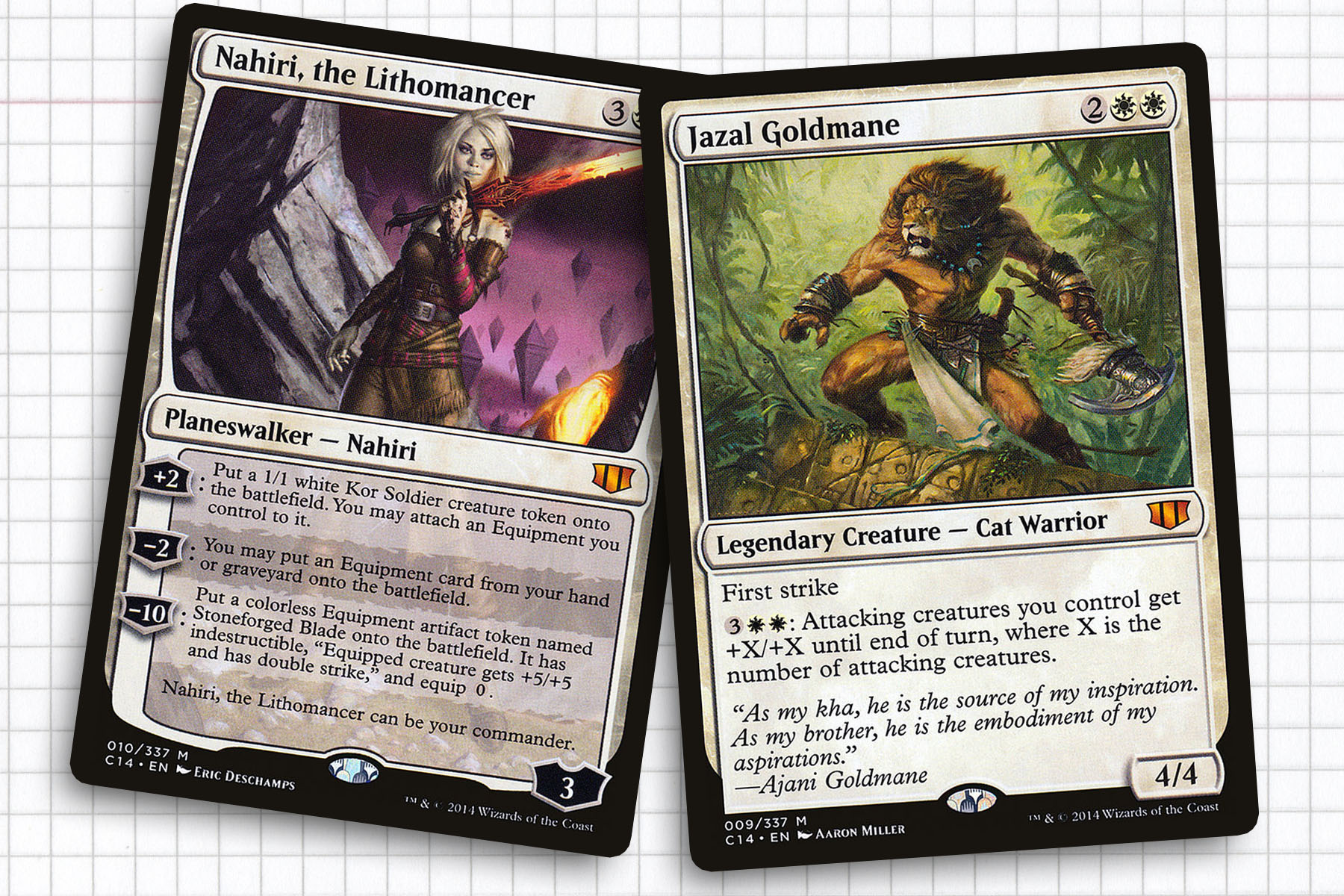
Forged in Stone
Part of the conceit of this product was introducing planeswalker cards for characters assumed to be dead within the narrative. One of those included part of the triad that had sealed away the Eldrazi, Nahiri, the Lithomancer. Nahiri is the eleventh most popular mono white commander and she sits at fourth in popularity for mono white equipment. This is likely helped by the fact that she has possibly the most linear design of the planeswalkers and she sticks to it.
I don’t know that Nahiri ever had a strong showing when she was initially printed, but the decks that wanted her have been happy to play her. Nahiri’s main competition at the time was Kemba, Kha Regent, and Nahiri brought some diversity to the archetype. Overall, Nahiri’s placement within White’s top generals even all these years later speaks to how powerful she can be within a popular archetype, while also reflecting her popularity as a character. And of course, Nahiri has reasserted herself in the current Magic story.
Jazal Goldmane has been a good general but missing one or two components. On its face, the ability to grant all attacking creatures a huge bonus seems impactful; with enough creatures you should be able to get one or two through for a huge sweep of damage. But without granting your team some form of evasion, the pump doesn’t do enough. Jazal does in fact work well in the remaining ninety-nine of a deck, which is a discussion we will return to for a number of the generals from this product.
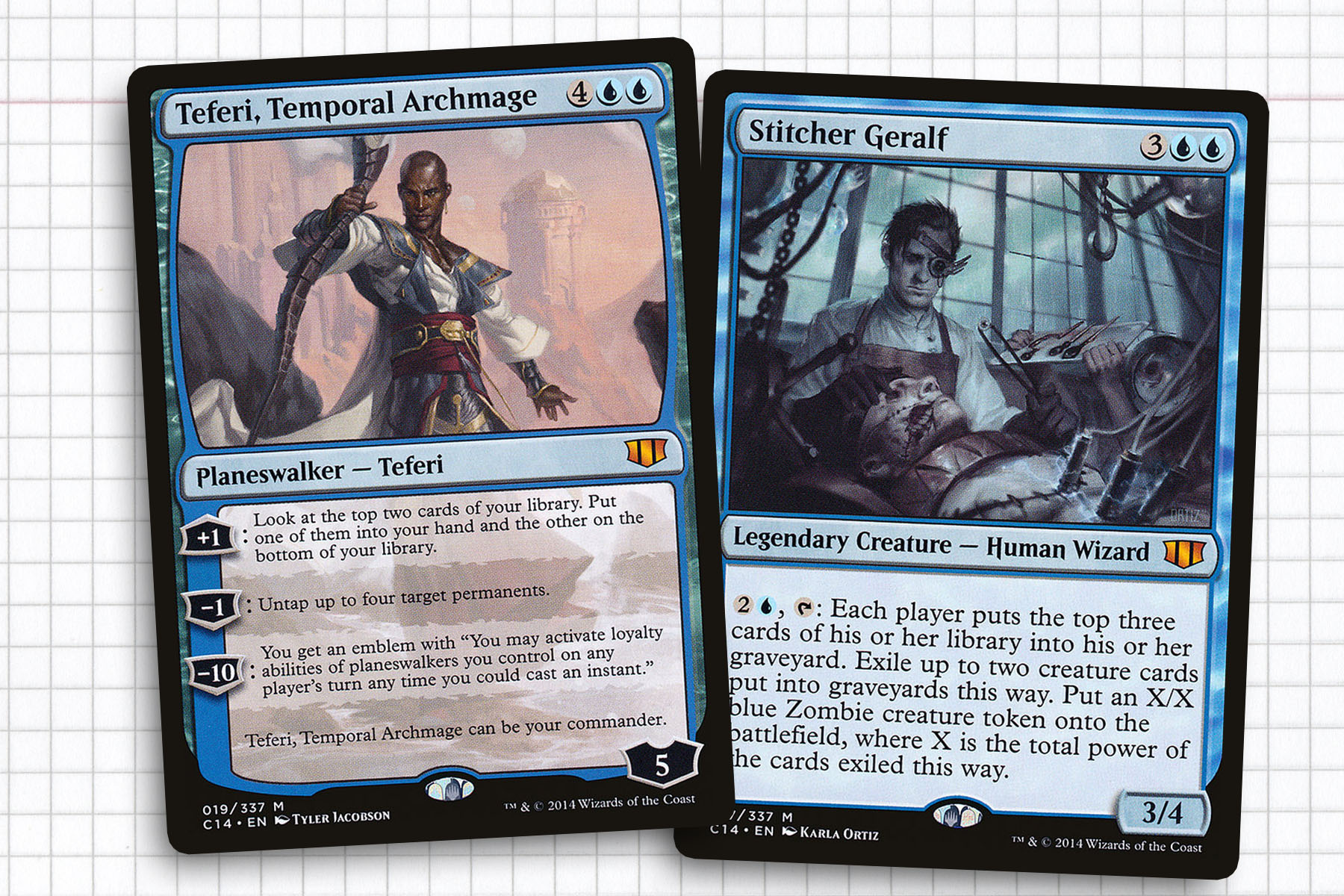
Peer Through Time
Turning our attention to another planeswalker which was intended to only show a small piece of a pre-Mending planeswalker’s powers, we finally saw Teferi ascended as Teferi, Temporal Archmage. Coming in as the fourteenth most popular mono blue commander, Teferi is in my mind the most broken of the five planeswalker entries in this product. Together with Tezzeret the Seeker and The Chain Veil, the metagame warped around properly addressing this deck in the months following Commander 2014’s release.
While it never required a banning, the overall trajectory of Teferi, Temporal Archmage reminds me a lot of the general sentiment around Leovold, Emissary of Trest: fun and powerful, but once most players had done the most powerful thing they could think of with Teferi, interest waned.
Stitcher Geralf introduced a different kind of zombie deck, which was welcome. Instead of trying to overwhelm opponents with hoards of zombies, Geralf wanted to supply you with a few monstrous zombies over the course of the game. I remember a degree of excitement around Geralf when he was previewed, but I think most of that stemmed from the character. Now, the card seems like a fun challenge to build around for a flavorful deck, or even mill. But ultimately, Geralf feels lost to time.
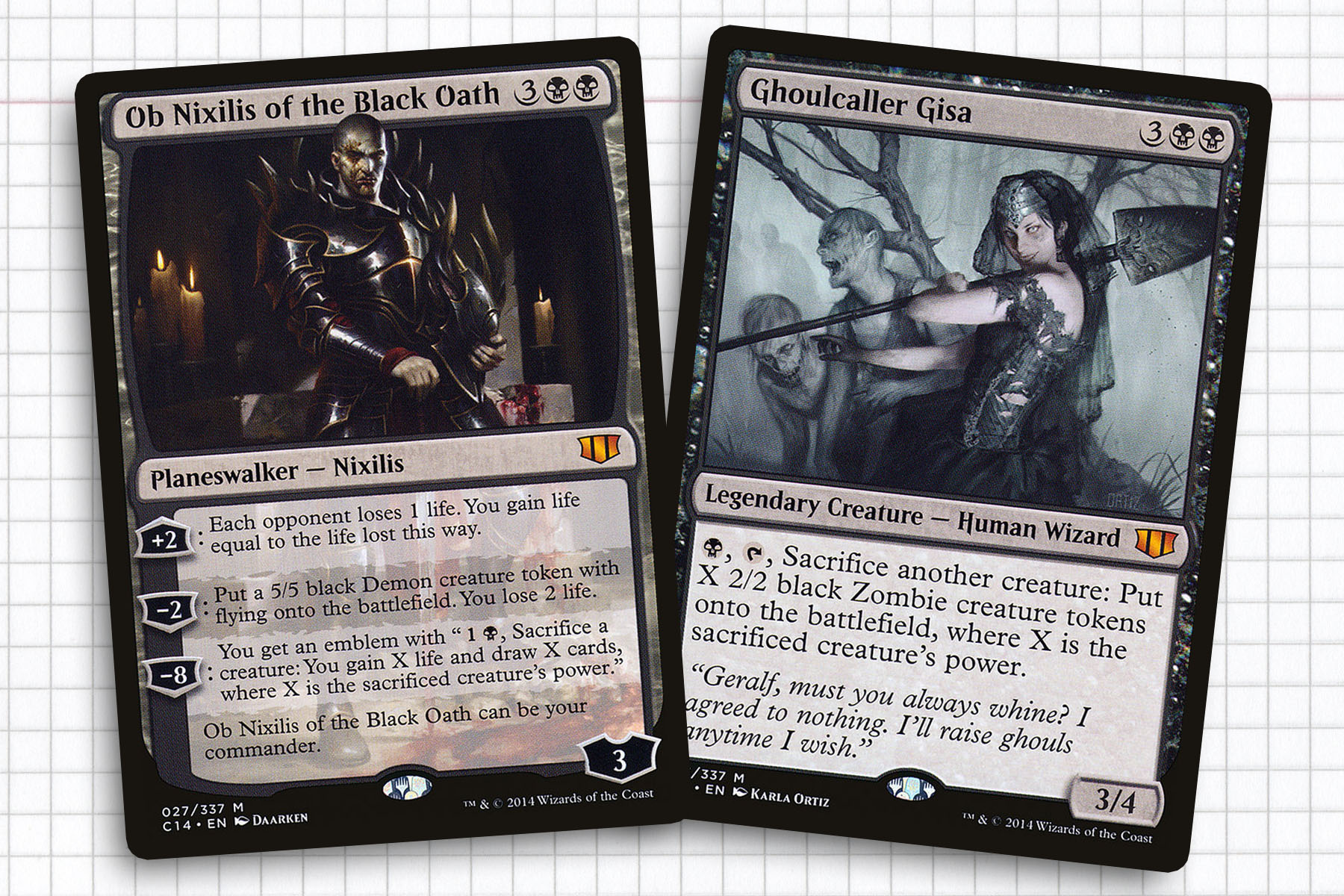
Sworn to Darkness
Having lived through the original release of Commander 2014, I can say that the mono black deck was rather forgettable. Both of the new generals in the deck were cohesive in that they wanted you to be sacrificing creatures in some form to progress the game. But history has not been kind to Ob Nixilis of the Black Oath, who falls outside of the top 25 mono black generals with currently less than 150 decks in the EDHrec database. Alternatively, Ghoulcaller Gisa is the thirteenth most popular mono black commander, with just under 400 decks currently.
So why have both of these generals failed to keep popularity within Commander? While it’s hard to say exactly, I see Ob Nixilis as being too generically black. He gains some life and makes a few demons, but he’s not a general I find myself wanting to cast every game. He takes forever to get to ultimate status, and his ultimate doesn’t set you up for victory very well. That said, I never mind him in the other ninety-nine, as he at least makes a 5/5 for five mana.
Gisa is a respectable zombie general that struggles as a mono-colored tribal general with better options in multiple colors. Zombies were already established in Dimir with Grimgrin, Corpse-Born and Sultai with Sidisi, Brood Tyrant. That said, printing Stitcher Geralf and Ghoulcaller Gisa fed a real demand for flavorful minor characters for the Vorthos fans. Wizards was able to give zombie tribal players Gisa and Geralf as a nice way of bringing the two together, allowing them to lead a flavorful deck in the absence of the partner mechanic. That’s a good thing.
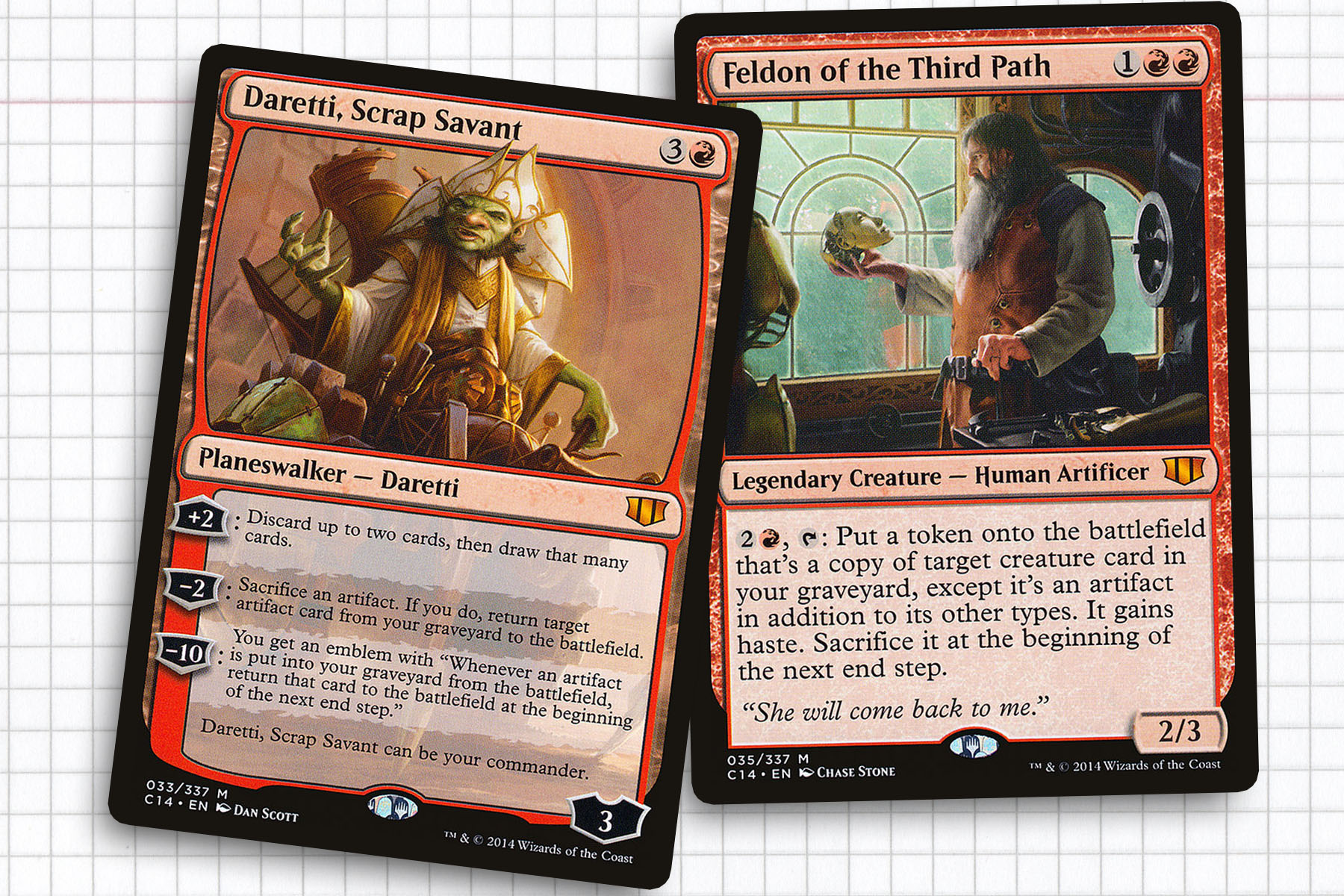
Built from Scratch
Daretti, Scrap Savant is the third most popular mono red commander, with Feldon of the Third Path closely falling at the seventh position. I think these high placings speak to just how attractive both are in terms of play style. By being red’s chief artifact general, Daretti carved a niche out for himself; in a similar vein, Feldon gave red a reanimator archetype that hadn’t been variable before. In short, other generals in the product supported archetypes, the red generals enabled new ones to develop. I have built both of these decks in the past and I would encourage players to consider building them as well.
In truth, I find myself with very little to say about this pair of generals. They are powerful without being overpowered and even after all this time, they have proven to be relevant pieces of the metagame. I think that they’re designs are both above average and I find Feldon’s design in particular to be a very interesting look into how red would handle reanimation. Like many of the other pairs we’ve discussed today, these two also work great in tandem with each other, Daretti filling up the graveyard with things to reanimate and Feldon creates attackers that can be later sacrificed to Daretti’s Trash for Treasure ability. Great job on the red deck, which is a real standout from the set.
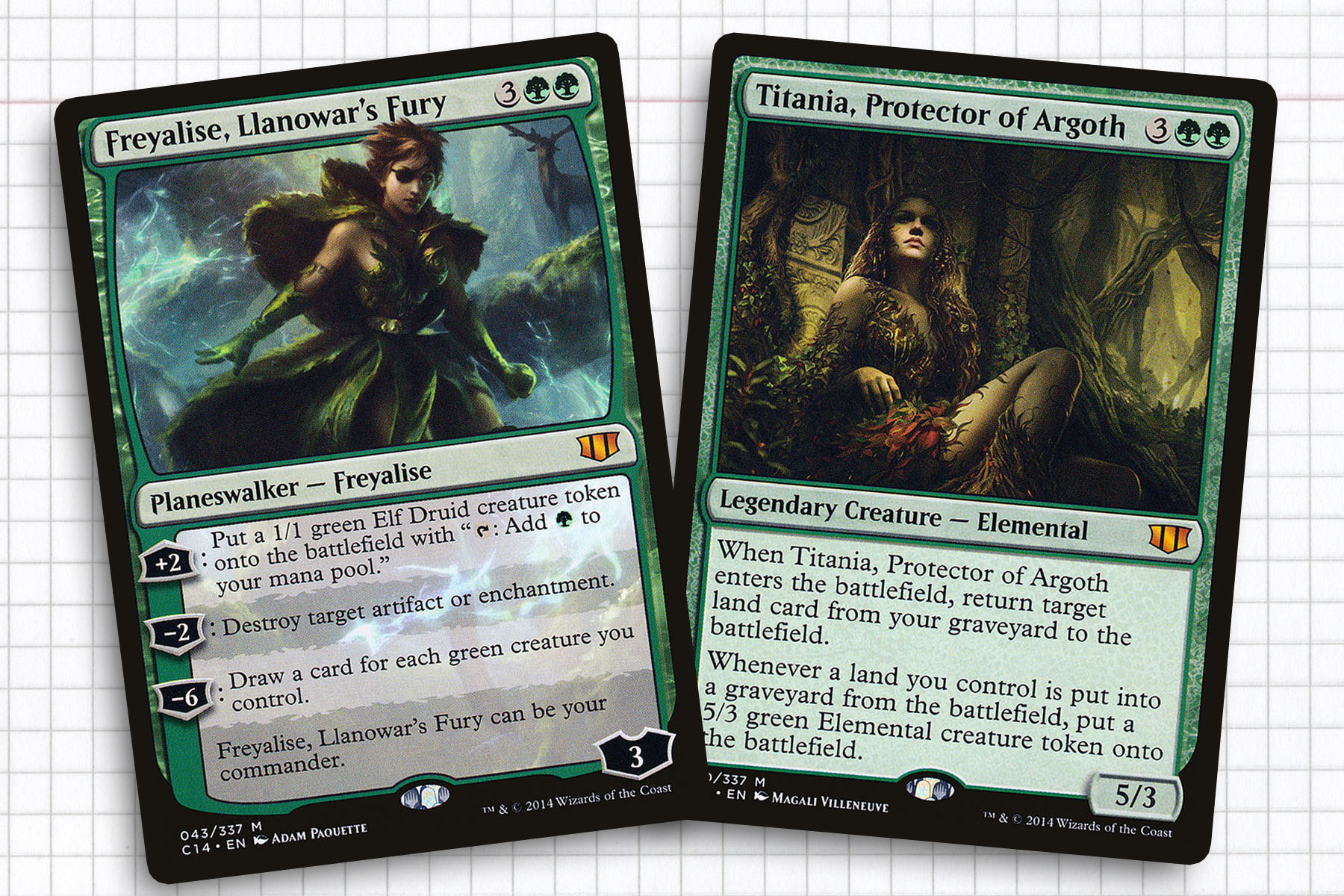
Guided by Nature
The green preconstructed deck was forgettable, but the two legendary permanents that came out of this deck are some of the most popular mono-green utility cards that have seen print: Freyalise and Titania. In a world before Vivien Reid, a planeswalker like Freyalise, Llanowar’s Fury who simply had Naturalize as one of its abilities was a strong reason to include it. Similarly, as lands decks have become more popular, Titania, Protector of Argoth has become a staple in the format.
Freyalise and Titania take the eleventh and twelfth most popular mono green commanders, respectively. Combining Llanowar Elves, Naturalize, and Regal Force into one card, Freyalise was good out of the box. Armed with Ezuri, Renegade Leader, Elvish Archdruid, and Immaculate Magistrate at the core of the deck, Freyalise was a solid elf tribal deck for those who didn’t want to venture into black with Nath of the Gilt-Leaf or white with Rhys the Redeemed. She had since fallen behind Ezuri and Marwyn, the Nurturer in recent years and she has taken her place as a support card.
Titania was very popular from the beginning, especially for her interaction with Dust Bowl, Petrified Field and fetchlands. As an endgame plan, Titania combined with Zuran Orb, Sylvan Safekeeper, or Claws of Gix would create a winning game state. But over time with the release of The Gitrog Monster, Omnath, Locus of Rage, and Lord Windgrace, she quietly found herself as the support card that enabled these decks to have the staying power.
Concluding Thoughts
I would be hard-pressed to consider any Commander product that has been released thus far to be a failure, but I do believe that Commander 2014 may have been the lowest point that we’ve seen. Being mono-colored is a hard theme to build around, because the decks don’t receive much cross pollination and the themes can devolve into just being philosophically generic to each color. That said, there is an audience that wants to see incentives to play the fewest colors in Commander and those kinds of answers are not going to be properly seen in a Standard-legal product.
At its weakest, this product introduced ten role-player cards that just so happened to be legendary. And unfortunately a Commander product is often judged by the strength of its potential generals. To its credit, I think the strongest aspect of the set was bringing some fan favorite planeswalkers into the game. I consider Daretti, Scrap Savant to be a nearly perfect design. Likewise, Nahiri has proven herself to be a character worthy of bringing back and adding red to color identity helped to give her a role within the roster of characters. And then there is Teferi, who existed in cardboard prior, but I think most would agree has become an ever present entity in the minds of Magic players after finally seeing print as a planeswalker. Until next time, thank you for reading.
Ryan Sainio is a Graphic Designer who writes about EDH and the EDH community. He has been playing Magic: the Gathering since 7th Edition in 2002 and values flavorful and fun gameplay over competitively optimized decks.

